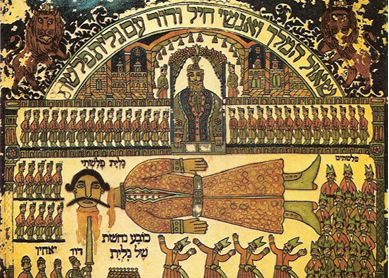In
While most writers use the story for its underdog overtones (the little guy wins), there are rich subtleties of the biblical narrative that writers of all stripes can mine. For example, David leaves behind his armor when he fights the militantly attired Goliath. Where Goliath is heavy and slow, David is light and agile. David is modest, but Goliath brags about his might. Less likely to show up in newsprint is the contrast that was most important to the biblical authors: David’s victory shows the power of his God, while Goliath’s defeat reveals the weakness of the Philistine deities.
When using the story of David and Goliath to describe a sporting event, most sports writers play up the opponents’ disparity in size. This report (Maxie Swain, “Cup’s David vs. Goliath,” Daily Mirror [UK], December 18, 2012) concerns soccer teams in Northern Ireland: “Ballynahinch United chief Colin Murray has likened his side’s Irish Cup clash with Coleraine to the biblical mismatch of David and Goliath. And unlike that famed giantkilling, Murray holds out little hope of landing a killer blow.” United fans doubtless hoped that their team might perform a “miracle” (a word actually used in this story), just as David did. Alas, Coleraine won 7-0.
In some newsrooms, the phrase “David and Goliath” can refer to a prolonged struggle instead of a single battle. In New York’s Daily News (Bill Madden, “Cinderella Talk Not for the Birds,” October 9, 2012), for example, the struggle between the two Hebrew Bible figures symbolizes an entire baseball season: “From April to October, [team manager Buck] Showalter’s Baltimore Orioles have been playing out this David and Goliath thing…the persistent overachieving underdogs confronting and conquering one seemingly insurmountable hurdle after another.”
Since the struggle between David and Goliath was an individual contest, many writers have understood individual sports in these terms. For example, this brief report from the British newspaper The Independent, (James Mariner, “Something from the Weekend,” June 4, 2012), subtitled “David and Goliath,” describes a singles tennis match: “Belgian plucky loser David Goffin took the opening set off his hero Roger Federer in the French Open yesterday before being overcome, and having his hair playfully ruffled by the Swiss maestro.” While it is unlikely that Goliath ever “playfully ruffled” anything of David’s, there is a connection between the Israelite boy David and the Belgian tennis player: “Goffin’s mere presence…made him the first ‘lucky loser’ to make the last sixteen…since 1995, after he replaced the injured Gaël Monfils.” Although he wasn’t technically a replacement player, David was certainly not among the most likely challengers of Goliath.
David’s victory over Goliath was not pure luck: his strategy to strike Goliath with a rock from a sling was a brilliant plan of attack. In the world of sports, some writers and coaches have taken this aspect of the story to heart. In a story about a soccer team, the Belfast Telegraph (“Victory of Biblical Proportions,” January 10, 2011) emphasizes David’s plan: victorious Stevenage manager Graham Westley “rammed home the story of ‘David and Goliath’ and how the little Israelite had defeated the giant champion of the Philistines by design, not by chance.” He continued: “We talked beforehand about David and Goliath. We talked about the fact that David had a plan. David knew what his strengths were. David didn’t play Goliath’s game. He played his own game.”
The story of David and Goliath can serve as shorthand for all sorts of battles of the weak versus the mighty, in the world of sports and beyond it. David might have approved. As for Goliath, surely that’s another story!
Bibliography
- Greenspoon, Leonard. The Bible in the News: How the Popular Press Relates, Conflates, and Updates Sacred Writ. Washington, D.C.: Biblical Archaeology Society, 2013.
- Gladwell, Malcolm. David and Goliath: Underdogs, Misfits, and the Art of Battling Giants. New York: Little, Brown, 2013.
- Greenspoon, Leonard. Jews in the Gym: Judaism, Sports, and Athletics. East Lafayette, Ind.: Purdue University Press, 2012.


